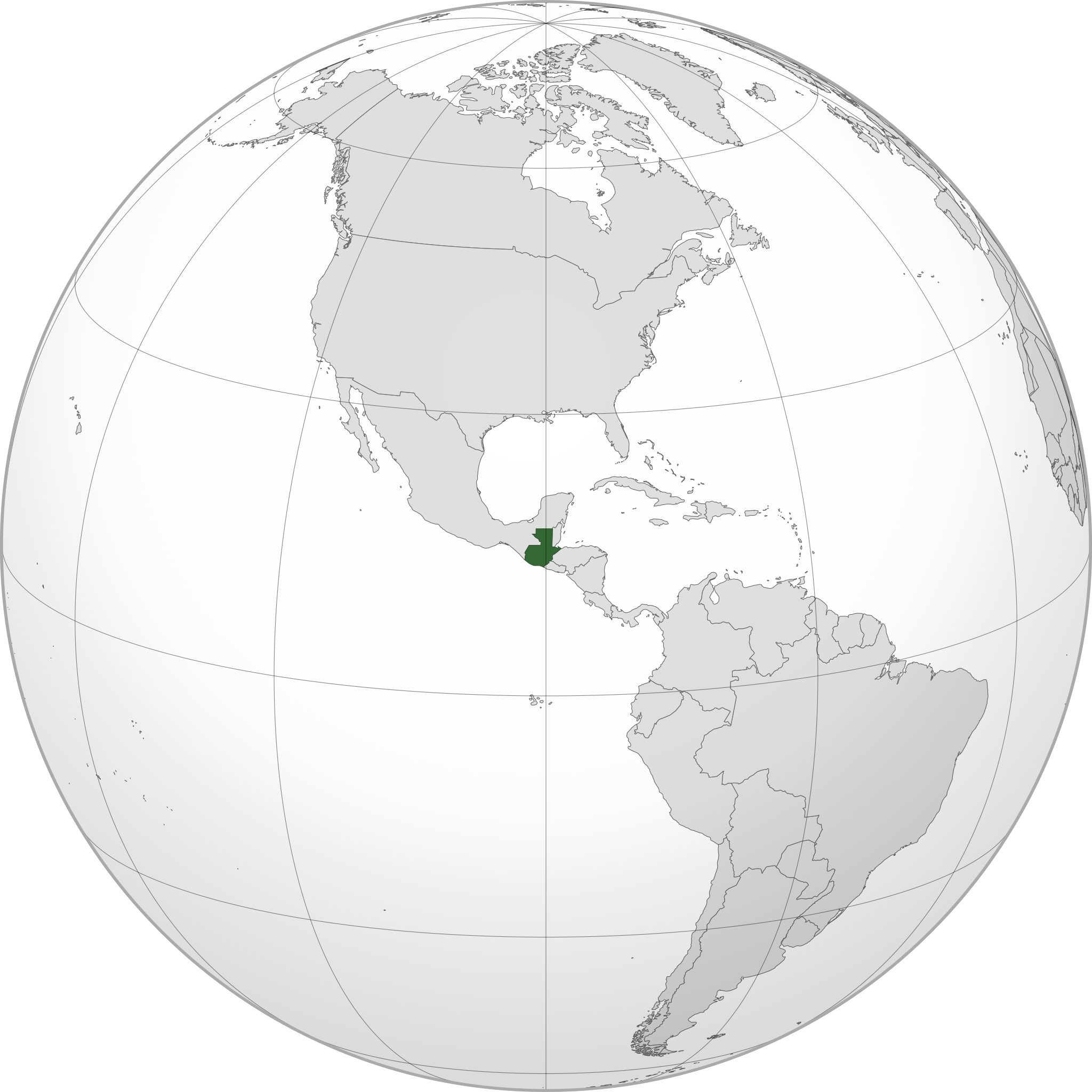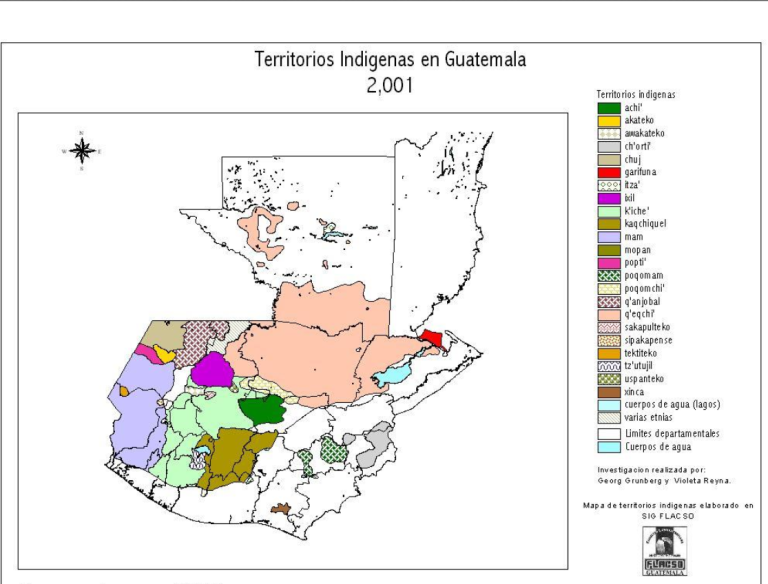More languages
More actions
No edit summary |
General-KJ (talk | contribs) m (Changed source formatting) Tag: Visual edit |
||
| (7 intermediate revisions by 2 users not shown) | |||
| Line 1: | Line 1: | ||
{{Infobox country|name=Republic of Guatemala|native_name=República de Guatemala|capital=Guatemala City|largest_city=Guatemala City|mode_of_production=[[Capitalism]]|image_map=Guatemala map.png|map_width=260|official_languages=Spanish|area_km2=108,889|population_estimate=17,263,239|population_estimate_year=2018}} | {{Infobox country|name=Republic of Guatemala|native_name=República de Guatemala|image_flag=Flag of Guatemala.svg|image_coat=Coat of arms of Guatemala.svg|capital=Guatemala City|largest_city=Guatemala City|mode_of_production=[[Capitalism]]|government_type=Presidential republic|leader_title1=President|leader_name1=[[Alejandro Giammattei]]|image_map=Guatemala map.png|map_width=260|official_languages=Spanish|area_km2=108,889|population_estimate=17,263,239|population_estimate_year=2018}} | ||
'''Guatemala''', officially the '''Republic of Guatemala''', is a country in [[Central America]]. | '''Guatemala''', officially the '''Republic of Guatemala''', is a country in [[Central America]]. 44% of its population is indigenous.<ref name=":2">{{Web citation|author=Jimmy Zúñiga Wallace, [[Ben Norton]]|newspaper=[[Geopolitical Economy Report]]|title=Guatemala blocks leftist Indigenous leader from presidential race, in ‘electoral coup’|date=2023-02-06|url=https://geopoliticaleconomy.com/2023/02/06/guatemala-blocks-leftist-indigenous-leader-from-presidential-race-in-electoral-coup/|archive-url=https://web.archive.org/web/20230210143555/https://geopoliticaleconomy.com/2023/02/06/guatemala-blocks-leftist-indigenous-leader-from-presidential-race-in-electoral-coup/|archive-date=2023-02-10|retrieved=2023-02-11}}</ref> | ||
== History == | == History == | ||
Military dictator [[Jorge Ubico]] was overthrown in 1944.<ref name=":1">{{Citation|author=William Blum|year=2003|title=Killing Hope|chapter=Guatemala 1953-1954: While the world watched|page=71|pdf=https://cloudflare-ipfs.com/ipfs/bafykbzacedfo2kzml5sodng4rtlybjdvertim3nybowazzlo6rztq6khixbv4?filename=William%20Blum%20-%20Killing%20Hope_%20US%20Military%20and%20CIA%20Interventions%20Since%20World%20War%20II-Zed%20Books%20Ltd%20%282003%29.pdf|city=London|publisher=Zed Books|isbn=1842773682}}</ref> | [[File:Guatemala indigenous map.png|thumb|Map of indigenous nations in Guatemala]] | ||
The [[United States of America|United States]] invaded Guatemala in 1920.<ref name=":0222">{{Citation|author=David Vine|year=2020|title=The United States of War|chapter=The Military Opens Doors|page=210|city=Oakland|publisher=University of California Press|isbn=9780520972070|lg=http://library.lol/main/191568BFAC73F009132DB00ECD0F0F05}}</ref> Military dictator [[Jorge Ubico]] was overthrown in 1944.<ref name=":1">{{Citation|author=William Blum|year=2003|title=Killing Hope|chapter=Guatemala 1953-1954: While the world watched|page=71|pdf=https://cloudflare-ipfs.com/ipfs/bafykbzacedfo2kzml5sodng4rtlybjdvertim3nybowazzlo6rztq6khixbv4?filename=William%20Blum%20-%20Killing%20Hope_%20US%20Military%20and%20CIA%20Interventions%20Since%20World%20War%20II-Zed%20Books%20Ltd%20%282003%29.pdf|city=London|publisher=Zed Books|isbn=1842773682}}</ref> | |||
=== Árbenz presidency === | === Árbenz presidency === | ||
Jacobo Árbenz was elected President of Guatemala in 1951. He redistributed land to 100,000 [[Peasantry|peasants]] and improved [[Trade union|unionization]] rights. The [[Central Intelligence Agency|CIA]] began planning to overthrow him in 1952. In 1954, the CIA bombed Guatemala and overthrew its government. Árbenz asked the [[United Nations]] and [[Organization of American States|OAS]] for help against the coup. [[Dwight D. Eisenhower|Dwight Eisenhower]] claimed that Guatemala was a [[Union of Soviet Socialist Republics (1922–1991)|Soviet]] puppet state, but Guatemala and the Soviet Union had no diplomatic relations or embassies.<ref name=":1" /> | Jacobo Árbenz was elected President of Guatemala in 1951. He redistributed land to 100,000 [[Peasantry|peasants]] and improved [[Trade union|unionization]] rights. The [[Central Intelligence Agency|CIA]] began planning to overthrow him in 1952. In 1954, the CIA bombed Guatemala and overthrew its government. Árbenz asked the [[United Nations]] and [[Organization of American States|OAS]] for help against the coup. [[Dwight D. Eisenhower|Dwight Eisenhower]] claimed that Guatemala was a [[Union of Soviet Socialist Republics (1922–1991)|Soviet]] puppet state, but Guatemala and the Soviet Union had no diplomatic relations or embassies.<ref name=":1" /> | ||
=== | === Ydígoras dictatorship === | ||
In November 1960, the military began a nationalist rebellion against Fuentes. The rebels, who included up to half of Guatemala's soldiers, took over two military bases. The CIA and [[Cuba|Cuban]] exiles bombed rebel-controlled areas, ending the rebellion within days.<ref>{{Citation|author=William Blum|year=2003|title=Killing Hope|chapter=Guatemala 1960: One good coup deserves another|page=146|pdf=https://cloudflare-ipfs.com/ipfs/bafykbzacedfo2kzml5sodng4rtlybjdvertim3nybowazzlo6rztq6khixbv4?filename=William%20Blum%20-%20Killing%20Hope_%20US%20Military%20and%20CIA%20Interventions%20Since%20World%20War%20II-Zed%20Books%20Ltd%20%282003%29.pdf|city=London|publisher=Zed Books|isbn=1842773682}}</ref> | In November 1960, the military began a nationalist rebellion against Fuentes. The rebels, who included up to half of Guatemala's soldiers, took over two military bases. The CIA and [[Cuba|Cuban]] exiles bombed rebel-controlled areas, ending the rebellion within days.<ref>{{Citation|author=William Blum|year=2003|title=Killing Hope|chapter=Guatemala 1960: One good coup deserves another|page=146|pdf=https://cloudflare-ipfs.com/ipfs/bafykbzacedfo2kzml5sodng4rtlybjdvertim3nybowazzlo6rztq6khixbv4?filename=William%20Blum%20-%20Killing%20Hope_%20US%20Military%20and%20CIA%20Interventions%20Since%20World%20War%20II-Zed%20Books%20Ltd%20%282003%29.pdf|city=London|publisher=Zed Books|isbn=1842773682}}</ref> | ||
| Line 18: | Line 19: | ||
=== Arana dictatorship === | === Arana dictatorship === | ||
Colonel [[Carlos Arana Osorio]] took power in 1970 and killed over 7,000 people in each year of his rule. Diplomats in Guatemala City believed that right-wing forces killed 15 times as many people as the guerrillas and revolutionaries. | Colonel [[Carlos Arana Osorio]] took power in 1970 and killed over 7,000 people in each year of his rule. Diplomats in Guatemala City believed that right-wing forces killed 15 times as many people as the guerrillas and revolutionaries.<ref name=":0" /> | ||
By 1976, the police, military, and death squads had killed over 20,000 people. Many bodies were thrown into rivers or the Pacific Ocean. In the Gualán area, people stopped fishing because they found so many corpses in the rivers. Suspected guerrillas were tortured with insecticide or electric shocks. Many people were found with their eyes gouged out or | By 1976, the police, military, and death squads had killed over 20,000 people. Many bodies were thrown into rivers or the Pacific Ocean. In the Gualán area, people stopped fishing because they found so many corpses in the rivers. Suspected guerrillas were tortured with insecticide or electric shocks. Many people were found with their eyes gouged out or their tongues and hands removed. The U.S. used F-51 planes to drop napalm over suspected guerrilla areas, similar to the [[Vietnam War]]. The [[Guatemalan Army of the Poor]] was formed in 1976 to resist the junta.<ref name=":0">{{Citation|author=William Blum|year=2004|title=Killing Hope|title-url=https://williamblum.org/books/killing-hope|chapter=Guatemala, 1962 to 1980s: A less publicized “final solution”|chapter-url=https://williamblum.org/chapters/killing-hope/guatemala|publisher=Common Courage Press|isbn=9781567512526}}</ref> | ||
=== Ríos dictatorship === | |||
[[Christianity|Christian]] fundamentalist [[Ríos Montt|Efraín Ríos Montt]] took power in a coup in 1982 and destroyed over 400 villages. He killed over 2,600 people during his six months in power. [[Ronald Reagan]] gave Ríos military supplies and denied human rights abuses.<ref name=":0" /> | |||
== Politics == | |||
The current Guatemalan government is [[Corruption|corrupt]] and [[Right-wing politics|right-wing]]. The indigenous [[Left-wing politics|leftist]] [[Movement for the Liberation of the Peoples]] ran for the first time in the 2019 elections, and its leader [[Thelma Cabrera]] received 10% of the vote while the current president Alejandro Giammattei received 14%. Giamattei is very [[Conservatism|conservative]] and a dual citizen of [[Italian Republic|Italy]]. The Supreme Electoral Tribunal blocked the MLP from running in the 2023 elections.<ref name=":2" /> | |||
== References == | == References == | ||
[[Category:Countries]] | |||
[[Category:Central American countries]] | [[Category:Central American countries]] | ||
[[Category:Latin American countries]] | [[Category:Latin American countries]] | ||
[[Category:North American countries]] | [[Category:North American countries]] | ||
<references /> | <references /> | ||
[[Category:Global south]] | |||
[[Category:Countries targeted by CIA coups]] | |||
[[Category:Countries invaded by the United States]] | |||
{{DEFAULTSORT:Guatemala}} | |||
Latest revision as of 23:13, 15 January 2024
| Republic of Guatemala República de Guatemala | |
|---|---|
 | |
| Capital and largest city | Guatemala City |
| Official languages | Spanish |
| Dominant mode of production | Capitalism |
| Government | Presidential republic |
• President | Alejandro Giammattei |
| Area | |
• Total | 108,889 km² |
| Population | |
• 2018 estimate | 17,263,239 |
Guatemala, officially the Republic of Guatemala, is a country in Central America. 44% of its population is indigenous.[1]
History[edit | edit source]

The United States invaded Guatemala in 1920.[2] Military dictator Jorge Ubico was overthrown in 1944.[3]
Árbenz presidency[edit | edit source]
Jacobo Árbenz was elected President of Guatemala in 1951. He redistributed land to 100,000 peasants and improved unionization rights. The CIA began planning to overthrow him in 1952. In 1954, the CIA bombed Guatemala and overthrew its government. Árbenz asked the United Nations and OAS for help against the coup. Dwight Eisenhower claimed that Guatemala was a Soviet puppet state, but Guatemala and the Soviet Union had no diplomatic relations or embassies.[3]
Ydígoras dictatorship[edit | edit source]
In November 1960, the military began a nationalist rebellion against Fuentes. The rebels, who included up to half of Guatemala's soldiers, took over two military bases. The CIA and Cuban exiles bombed rebel-controlled areas, ending the rebellion within days.[4]
In 1962, thousands of people protested against the government of Ydigoras Fuentes and began a general strike. The police and military eventually ended the protest. The United States established a military base in the northeast to teach counter-insurgency tactics to the Guatemalan military. Fuentes lost U.S. support when he allowed former progressive leader Juan José Arévalo to return to the country, and he planned to step down in 1964 and allow an election. In March 1963 the United States organized another coup, and Colonel Enrique Peralta overthrew Fuentes.[5]
Peralta dictatorship[edit | edit source]
Peralta executed eight trade union leaders by driving trucks over them. He did not allow the U.S. to supply troops to fight the guerrillas and preferred to use his own soldiers. In March 1966, Julio César Méndez won an election and took power as a U.S.-backed civilian leader. A few days after he took office, Colonel John D. Webber, Jr. arrived in Guatemala to take control of the U.S. military mission. Between October 1966 and March 1968, the police and military killed between 3,000 and 8,000 Guatemalans. Most of the people killed were not actual guerrillas. In January 1968, guerrillas assassinated Webber as revenge for his imperialist actions.[5]
Arana dictatorship[edit | edit source]
Colonel Carlos Arana Osorio took power in 1970 and killed over 7,000 people in each year of his rule. Diplomats in Guatemala City believed that right-wing forces killed 15 times as many people as the guerrillas and revolutionaries.[5]
By 1976, the police, military, and death squads had killed over 20,000 people. Many bodies were thrown into rivers or the Pacific Ocean. In the Gualán area, people stopped fishing because they found so many corpses in the rivers. Suspected guerrillas were tortured with insecticide or electric shocks. Many people were found with their eyes gouged out or their tongues and hands removed. The U.S. used F-51 planes to drop napalm over suspected guerrilla areas, similar to the Vietnam War. The Guatemalan Army of the Poor was formed in 1976 to resist the junta.[5]
Ríos dictatorship[edit | edit source]
Christian fundamentalist Efraín Ríos Montt took power in a coup in 1982 and destroyed over 400 villages. He killed over 2,600 people during his six months in power. Ronald Reagan gave Ríos military supplies and denied human rights abuses.[5]
Politics[edit | edit source]
The current Guatemalan government is corrupt and right-wing. The indigenous leftist Movement for the Liberation of the Peoples ran for the first time in the 2019 elections, and its leader Thelma Cabrera received 10% of the vote while the current president Alejandro Giammattei received 14%. Giamattei is very conservative and a dual citizen of Italy. The Supreme Electoral Tribunal blocked the MLP from running in the 2023 elections.[1]
References[edit | edit source]
- ↑ 1.0 1.1 Jimmy Zúñiga Wallace, Ben Norton (2023-02-06). "Guatemala blocks leftist Indigenous leader from presidential race, in ‘electoral coup’" Geopolitical Economy Report. Archived from the original on 2023-02-10. Retrieved 2023-02-11.
- ↑ David Vine (2020). The United States of War: 'The Military Opens Doors' (p. 210). Oakland: University of California Press. ISBN 9780520972070 [LG]
- ↑ 3.0 3.1 William Blum (2003). Killing Hope: 'Guatemala 1953-1954: While the world watched' (p. 71). [PDF] London: Zed Books. ISBN 1842773682
- ↑ William Blum (2003). Killing Hope: 'Guatemala 1960: One good coup deserves another' (p. 146). [PDF] London: Zed Books. ISBN 1842773682
- ↑ 5.0 5.1 5.2 5.3 5.4 William Blum (2004). Killing Hope: 'Guatemala, 1962 to 1980s: A less publicized “final solution”'. Common Courage Press. ISBN 9781567512526


